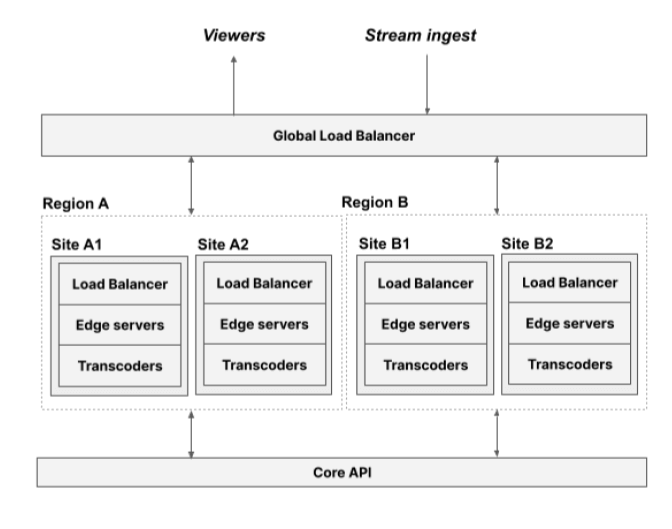Vindral LiveCloud has been designed from the ground up to be fault-tolerant and redundant in all system and application layers. This design creates a secure, stable, and highly available service designed for 24/7 operations at scale. The fault-tolerant architecture applies to all core features of the platform, including ingest, transcoding, egress, load balancing, traffic routing, back-end API:s, and geo-load-balancing.
Regional peering issues, data center outages, server crashes, partial overload, or similar incidents are automatically resolved or mitigated in Vindral LiveCloud. Due to the high availability architecture, Vindral LiveCloud customers do not suffer out-of-service scenarios caused by planned service windows or upgrades. The high-availability design is natively implemented in Vindral LiveCloud and marks a fundamental platform characteristic.
Solving the problem of an efficient edge-to-client transport protocol for ULL streaming is an important milestone for all vendors of ULL-streaming services. Whether the service is based on LL-HLS, chunked CMAF, WebRTC, or WebSockets does not make much of a difference in relation to implementation efforts and investments. However, building a multi-tenant solution running as a scalable global service at 24/7 is a different story.
Per Mafrost, CTO of RealSprint
Our technology investments, particularly in fault tolerance, independence, and scalability, are just as instrumental as the investments in the protocol itself. I firmly believe that our tech stack, which can even be licensed as a white-label solution for anyone running a ULL streaming service or application, is more flexible and cost-efficient than other alternatives- especially for customers targeting a large audience where egress capacity and traffic costs are the main concerns
Geo load-balancing
As egress services within Vindral LiveCloud are managed via a global server load balancer (GSLB), all egress traffic will be served by the data center closest to the viewer. If this data center is overloaded, offline, under maintenance, or similar, the second closest available data center will be used. Within each data center, Vindral LiveCloud provides automatic load-balancing between all edge servers.

Edge throughput
The edge servers of Vindral LiveCloud are incredibly lightweight and highly performant, supporting TLS offloading to HW-accelerated termination on either NIC or CPU.
Fault-tolerant ingest and transcoding
Ingesting into Vindral LiveCloud is not limited to a single ingest server or data center. The ingest URL is served via a load- and geo-balanced cluster of data centers. If one of those data centers is unavailable, offline, or overloaded, the ingest will automatically be re-routed to an alternative data center close to the origin.
Once the ingest arrives at the ingest site, transcoding is initialized. In most cases, transcoding occurs at the same data center as the ingest. However, in the event of high load or if HW-accelerated transcoding is required (AV1, for example), transcoding can be performed in a different data center than the ingest site. This design also mitigates local transcoding issues or transcoder outages in data centers.
Our customers expect 100% uptime and a reliable and secure service. Because of these requirements, our multi-layered failover and fault-tolerant architecture are among the most valuable and essential features of our core service. Lessons learned from running a ULL service over several years have impacted our product roadmap and system design. Stability and uptime are our highest priority, and I’m proud to confirm that our statistics and uptime are more than satisfying. Running thousands of 24/7 HD- or 4K channels works effortlessly in Vindral LiveCloud
Niclas Åström, CPO of RealSprint
100% uptime, even during maintenance or upgrades
Vindral LiveCloud architecture allows for traffic rerouting and temporary decommissioning of active data centers. All viewers, ingest, and transcoding can seamlessly move from one data center to another to enable maintenance or upgrades without any service interruption for customers.
An independent hybrid
Vindral LiveCloud is designed to operate independently of the underlying service providers such as AWS, GCP, and Azure. Vindral LiveCloud can run on all cloud providers, bare-metal servers provided by different vendors, and servers (colocation) managed by us or our customers. The independence of running Vindral LiveCloud in multiple locations and on the virtual and bare-metal servers of different providers enables us to scale our service and the freedom to grow with greater flexibility.
Using Vindral LiveCloud’s built-in traffic routing features, traffic is optimized, and even customer-specific edge servers are allocated locally, allowing us to easily adapt to different use cases and requirements.
Scaling, HW-acceleration, and carbon footprints
Vindral LiveCloud’s highly efficient transcoder has been designed to support a multitude of hardware platforms, including hardware-accelerated encoding using ASICs (e.g., NETINT), Quicksync-powered CPUs from Intel, GPU-accelerated encoders from Nvidia (NVENC), and regular CPU:s from Intel, AMD, and ARM. As transcoding an extensive ABR ladder is computationally intense, RealSprint strives to use the most cost-efficient, energy-efficient, and compact (high-density) encoder option.
In 2022, RealSprint introduced NETINT’s Quadra T2 ASICS into Vindral LiveCloud. The Quadra platform generates 40x more compute efficiency compared to a regular CPU, and reduces the carbon footprint by 1/80th.
Vindral LiveCloud was built upon a set of principles, of which Robustness is one. Our team finds great joy in the craft, and a job well done is something we go out of our way to achieve. With much of new product development being rushed by the competition, our company culture stands in contrast with attention to detail as a cornerstone. Naturally, a quick GTM is necessary, but never at the expense of quality. We are most proud when our clients show appreciation towards the fact that Vindral LiveCloud stands out in terms of resilience and dependability
Daniel Alinder, CEO of RealSprint

